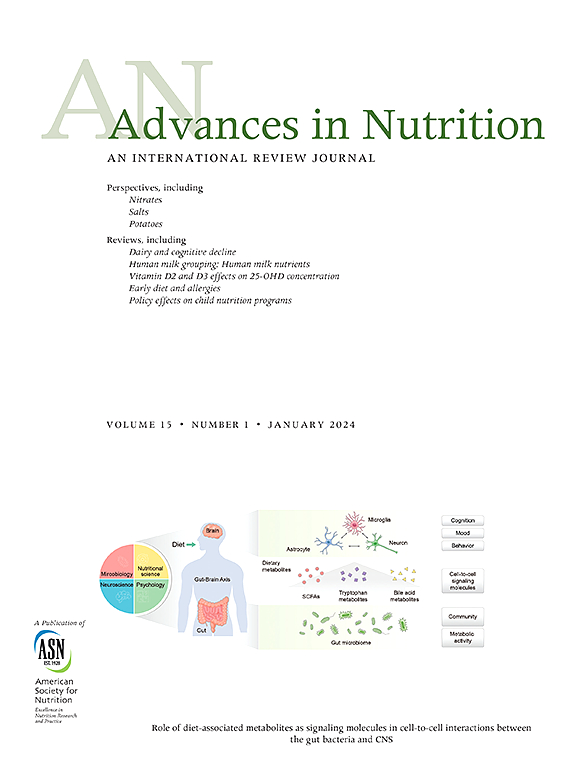在全基因组关联研究时代了解维生素状态生物标志物的基因结构:生物学见解和临床意义。
IF 9.2
1区 医学
Q1 NUTRITION & DIETETICS
引用次数: 0
摘要
维生素对人体健康起着内在作用,是通过饮食或药物方法进行临床干预的目标。维生素状态的生物标志物是一种复杂的性状和可测量的表型,是由膳食和其他环境因素与多基因遗传因素相互作用而产生的。研究这些遗传影响因素将提高我们对基本维生素生物化学的认识,完善维生素对人体健康影响的估计,并可能在未来被证明具有临床可操作性。在这里,我们评估了在无假设全基因组关联研究(GWAS)时代对维生素状态的循环和排泄生物标志物的遗传研究,这些研究为我们了解这些特征的遗传结构提供了前所未有的视角。我们发现,目前最全面、最有效的全基因组关联研究针对的是维生素 A、C、D 和 B 族维生素(B9 和 B12)的循环状态生物标志物。然后从关键基因和高阶过程两个方面讨论了每种维生素的生物标记物的 GWAS 所涉及的生物学。在所有主要维生素中,GWAS 发现了一些可与已知维生素生物化学直接关联的遗传信号。我们还概述了与维生素状态生物标志物相关的基因变异是如何被广泛用于估算维生素对人类健康结果的因果效应的,这一点尤为重要,因为大量与维生素相关的干预措施随机对照试验的结果都是无效的。最后,我们讨论了维生素基因组学研究结果临床适用性的现有证据,以及该领域最大限度地利用这些数据的未来方向。本文章由计算机程序翻译,如有差异,请以英文原文为准。
Understanding the Genetic Architecture of Vitamin Status Biomarkers in the Genome-Wide Association Study Era: Biological Insights and Clinical Significance
Vitamins play an intrinsic role in human health and are targets for clinical intervention through dietary or pharmacological approaches. Biomarkers of vitamin status are complex traits, measurable phenotypes that arise from an interplay between dietary and other environmental factors with a genetic component that is polygenic, meaning many genes are plausibly involved. Studying these genetic influences will improve our knowledge of fundamental vitamin biochemistry, refine estimates of the effects of vitamins on human health, and may in future prove clinically actionable. Here, we evaluate genetic studies of circulating and excreted biomarkers of vitamin status in the era of hypothesis-free genome-wide association studies (GWAS) that have provided unprecedented insights into the genetic architecture of these traits. We found that the most comprehensive and well-powered GWAS currently available were for circulating status biomarkers of vitamin A, C, D, and a subset of the B vitamins (B9 and B12). The biology implicated by GWAS of measured biomarkers of each vitamin is then discussed, both in terms of key genes and higher-order processes. Across all major vitamins, there were genetic signals revealed by GWAS that could be directly linked with known vitamin biochemistry. We also outline how genetic variants associated with vitamin status biomarkers have been already extensively used to estimate causal effects of vitamins on human health outcomes, which is particularly important given the large number of randomized control trials of vitamin related interventions with null findings. Finally, we discuss the current evidence for the clinical applicability of findings from vitamin GWAS, along with future directions for the field to maximize the utility of these data.
求助全文
通过发布文献求助,成功后即可免费获取论文全文。
去求助
来源期刊

Advances in Nutrition
医学-营养学
CiteScore
17.40
自引率
2.20%
发文量
117
审稿时长
56 days
期刊介绍:
Advances in Nutrition (AN/Adv Nutr) publishes focused reviews on pivotal findings and recent research across all domains relevant to nutritional scientists and biomedical researchers. This encompasses nutrition-related research spanning biochemical, molecular, and genetic studies using experimental animal models, domestic animals, and human subjects. The journal also emphasizes clinical nutrition, epidemiology and public health, and nutrition education. Review articles concentrate on recent progress rather than broad historical developments.
In addition to review articles, AN includes Perspectives, Letters to the Editor, and supplements. Supplement proposals require pre-approval by the editor before submission. The journal features reports and position papers from the American Society for Nutrition, summaries of major government and foundation reports, and Nutrient Information briefs providing crucial details about dietary requirements, food sources, deficiencies, and other essential nutrient information. All submissions with scientific content undergo peer review by the Editors or their designees prior to acceptance for publication.
 求助内容:
求助内容: 应助结果提醒方式:
应助结果提醒方式:


